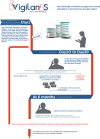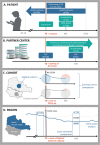Combining brief contact interventions (BCI) into a decision-making algorithm to reduce suicide reattempt: the VigilanS study protocol
- PMID: 30355792
- PMCID: PMC6224763
- DOI: 10.1136/bmjopen-2018-022762
Combining brief contact interventions (BCI) into a decision-making algorithm to reduce suicide reattempt: the VigilanS study protocol
Abstract
Introduction: The early postattempt period is considered to be one of the most at-risk time windows for suicide reattempt or completion. Among the postcrisis prevention programmes developed to compensate for this risk, brief contact interventions (BCIs) have been proven to be efficient but not equally for each subpopulation of attempters. VigilanS is a region-wide programme that relies on an algorithmic system to tailor surveillance and BCI provisions to individuals discharged from the hospital after a suicide attempt.
Aim: VigilanS' main objective is to reduce suicide and suicide reattempt rates both at the individual level (patients included in VigilanS) and at the populational level (inhabitants of the Nord-Pas-de-Calais region).
Methods and analysis: At discharge, every attempter coming from a participating centre is given a crisis card with an emergency number to contact in case of distress. Patients are then systematically recontacted 6 months later. An additional 10-day call is also given if the index suicide attempt is not the first one. Depending on the clinical evaluation during the phone call, the call team may carry out proportionated crisis interventions. Personalised postcards are sent whenever patients are unreachable by phone or in distress. On the populational level, mean suicide and suicide attempt rates in Nord-Pas-de-Calais will be compared before and after the implementation of the programme. Here/there cross-sectional comparisons with a control region will test the spatial specificity of the observed fluctuations, while time-series analyses will be performed to corroborate the temporal plausibility of imputing these fluctuations to the implementation of the programme. On the individual level, patients entered in VigilanS will be prospectively compared with a matched control cohort by means of survival analyses (survival curve comparisons and Cox models).
Discussion: VigilanS interventional components fall under the ordinary law care regime, and the individuals' general rights as patients apply with no addendums or restrictions for their participation in the programme. The research section received authorisation from the Ethical Committee of Lille Nord-Ouest under the caption 'Study aimed at evaluating routine care' and is registered in 'Clinical Trials'. The French Ministry of Health plans to extend the experimentation to other regions and probe the relevance of this type of 'bottom-up' territorial prevention policy at the national level.
Trial registration number: NCT03134885.
Keywords: crisis management; emergencies; organization of healthcare; prevention; suicide; telemedicine.
© Author(s) (or their employer(s)) 2018. Re-use permitted under CC BY-NC. No commercial re-use. See rights and permissions. Published by BMJ.
Conflict of interest statement
Competing interests: None declared.
Figures



References
Publication types
MeSH terms
Associated data
LinkOut - more resources
Full Text Sources
Medical
Miscellaneous
